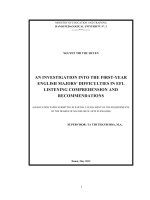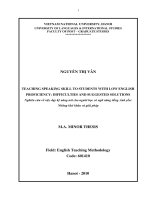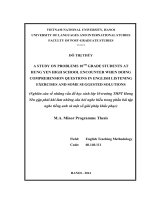Some obstacles facing HPU 2nd year English majors in English listening comprehension and suggested solutions
Bạn đang xem bản rút gọn của tài liệu. Xem và tải ngay bản đầy đủ của tài liệu tại đây (858.97 KB, 73 trang )
BỘ GIÁO DỤC VÀ ĐÀO TẠO
TRƯỜNG ĐẠI HỌC DÂN LẬP HẢI PHÒNG
-------------------------------
ISO 9001 : 2008
KHÓA LUẬN TỐT NGHIỆP
NGÀNH: NGOẠI NGỮ
HẢI PHÒNG - 2012
1
HAIPHONG PRIVATE UNIVESITY
FOREIGN LANGUAGES DEPARTMENT
-----------------------------------
GRADUATION PAPER
SOME OBSTACLES FACING HPU 2ND YEAR
ENGLISH MAJORS IN ENGLISH LISTENING
COMPREHENSION AND SUGGESTED SOLUTIONS
By:
Vu Thi Thu Trang
Class:
NA1202
Supervisor:
Nguyen Thi Quynh Hoa, (M.A.)
HAI PHONG - 2012
2
BỘ GIÁO DỤC VÀ ĐÀO TẠO
TRƯỜNG ĐẠI HỌC DÂN LẬP HẢI PHÒNG
--------------------------------------
NhiÖm vô ®Ò tµi tèt nghiÖp
Sinh viên: ............................................................Mã
số:............................
Lớp:
.............................Ngành:....................................................................
Tên đề tài:
.................................................................................................
..............................................................................................
....
3
Nhiệm vụ đề tài
1. Nội dung và các yêu cầu cần giải quyết trong nhiệm vụ đề tài tốt
nghiệp
( về lý luận, thực tiễn, các số liệu cần tính toán và các bản vẽ).
……………………………………………………………………………..
……………………………………………………………………………..
……………………………………………………………………………..
……………………………………………………………………………..
……………………………………………………………………………..
……………………………………………………………………………..
……………………………………………………………………………..
……………………………………………………………………………..
2. Các số liệu cần thiết để thiết kế, tính toán.
……………………………………………………………………………..
……………………………………………………………………………..
……………………………………………………………………………..
……………………………………………………………………………..
……………………………………………………………………………..
……………………………………………………………………………..
……………………………………………………………………………..
……………………………………………………………………………..
……………………………………………………………………………..
3. Địa điểm thực tập tốt nghiệp.
……………………………………………………………………………..
……………………………………………………………………………..
……………………………………………………………………………..
4
CÁN BỘ HƯỚNG DẪN ĐỀ TÀI
Người hướng dẫn thứ nhất:
Họ và tên:.............................................................................................
Học hàm, học vị:...................................................................................
Cơ quan công tác:.................................................................................
Nội dung hướng dẫn:............................................................................
Người hướng dẫn thứ hai:
Họ và tên:.............................................................................................
Học hàm, học vị:...................................................................................
Cơ quan công tác:.................................................................................
Nội dung hướng dẫn:............................................................................
Đề tài tốt nghiệp được giao ngày
tháng
Yêu cầu phải hoàn thành xong trước ngày
Đã nhận nhiệm vụ ĐTTN
năm 2012
tháng
năm 2012
Đã giao nhiệm vụ ĐTTN
Người hướng dẫn
Sinh viên
Hải Phòng, ngày tháng năm 2012
HIỆU TRƯỞNG
GS.TS.NGƯT Trần Hữu Nghị
5
PHẦN NHẬN XÉT TÓM TẮT CỦA CÁN BỘ HƯỚNG DẪN
1. Tinh thần thái độ của sinh viên trong quá trình làm đề tài tốt
nghiệp:
……………………………………………………………………………..
……………………………………………………………………………..
……………………………………………………………………………..
……………………………………………………………………………..
……………………………………………………………………………..
……………………………………………………………………………..
……………………………………………………………………………..
……………………………………………………………………………..
2. Đánh giá chất lượng của khóa luận (so với nội dung yêu cầu đã đề ra
trong nhiệm vụ Đ.T. T.N trên các mặt lý luận, thực tiễn, tính toán số
liệu…):
……………………………………………………………………………..
……………………………………………………………………………..
……………………………………………………………………………..
……………………………………………………………………………..
……………………………………………………………………………..
……………………………………………………………………………..
……………………………………………………………………………..
……………………………………………………………………………..
……………………………………………………………………………..
3. Cho điểm của cán bộ hướng dẫn (ghi bằng cả số và chữ):
……………………………………………………………………………..
……………………………………………………………………………..
……………………………………………………………………………..
Hải Phòng, ngày ….. tháng ..… năm 2012
Cán bộ hướng dẫn
(họ tên và chữ ký)
6
NHẬN XÉT ĐÁNH GIÁ
CỦA NGƯỜI CHẤM PHẢN BIỆN ĐỀ TÀI TỐT NGHIỆP
1. Đánh giá chất lượng đề tài tốt nghiệp về các mặt thu thập và phân tích tài
liệu, số liệu ban đầu, giá trị lí luận và thực tiễn của đề tài.
2. Cho điểm của người chấm phản biện :
(Điểm ghi bằng số và chữ)
Ngày.......... tháng......... năm 2012
Người chấm phản biện
7
ACKNOWLEDGEMENTS
First of all, I would like to express my sincere gratitude to my supervisor, Ms.
Nguyen Thi Quynh Hoa for her generous assistance, enthusiastic guidance
and constructive supervision throughout my thesis. Without her help, this
graduation paper would not have been completed.
I also wish to acknowledge indebtedness to all the teachers at Faculty of
Foreign Languages, HPU for their valuable lectures and instructions during
the past years, which has helped me much in completing the final task.
I am grateful to HPU 2nd year English majors and all the English teachers for
their enthusiastic participation in completing my survey questionnaires.
Finally yet importantly, I would like to thank my family members who
always stand by my side while the work was in process.
Haiphong, July 2012
Student
Vu Thi Thu Trang
8
9
TABLE OF CONTENTS
Acknowledgements
Table of contents
Lists of figures and tables
PART I: INTRODUCTION ........................................................................... 1
1. Rationale........................................................................................................ 1
2. Aims of the study .......................................................................................... 1
3. Research questions ........................................................................................ 2
4. The significance of the study ........................................................................ 2
5. Scope of the study ......................................................................................... 2
6. Methods of the study ..................................................................................... 2
7. Design of the study........................................................................................ 3
PART II: DEVELOPMENT .......................................................................... 4
CHAPTER 1: THEORETICAL BACKGROUND ..................................... 4
1. LISTENING .................................................................................................. 4
1.1. Definition of listening ................................................................................ 4
1.2 Classification of listening ............................................................................ 6
2. LISTENING COMPREHENSION ............................................................. 10
2.1 Defining listening comprehension ............................................................ 10
2.2. Listening comprehension process ............................................................ 13
2.3. The stages in listening comprehension .................................................... 15
3. POTENTIAL DIFFICULTIES IN LISTENING COMPREHENSION ..... 17
3.1. Listening problems ................................................................................... 17
3.2. Language problems .................................................................................. 21
CHAPTER 2: RESEARCH METHODOLOGY ....................................... 23
2.1. Introduction............................................................................................ 23
2.2. The setting of the study ............................................................................ 23
2.2.1. Students and their background .............................................................. 23
2.2.2. Resources and materials ........................................................................ 24
2.3. The subjects .............................................................................................. 24
2.4. Instruments for collecting data ................................................................. 24
2.5. Data collection procedure ........................................................................ 25
10
CHAPTER 3: DATA ANALYSIS ............................................................... 27
3.1. Analyzing from the students’ survey questionnaire................................. 27
3.1.1 Years of studying English(Q1) .............................................................. 27
3.1.2 Students’ attitude toward listening skill (Q2&3) ................................... 28
3.1.3. Students’ time allocation for self-study (Q4) ......................................... 29
3.1.4.Students’ opinion about their self-collected materials exploited(Q7) ..... 30
3.1.5 Student’s perceptions about their listening difficulties (Q5) ................... 31
3.1.6 Student’s opinions on the materials supplied by the teachers (Q6) ......... 33
Figure 8: Students opinions on the materials supplied by the teachers. ........... 33
3.2. Analyzing from the teachers’ survey questionnaire .................................. 34
3.2.1. Teachers’ opinions on students’ competence during their first two years
in the university. .............................................................................................. 34
3.2.2 Teachers’ opinions on students’ common difficulties in listening lessons 35
3.2.3 Teachers’ opinions on the materials supplying to the students(Q3) ....... 37
3.2.4 Teachers’ opinions on the ways to help students improve their listening skill
......................................................................................................................... 37
3.2.5 Teachers’ suggestions to the students to enhance their listening
competence. ..................................................................................................... 38
CHAPTER 4: FINDINGS, DISCUSSIONS AND RECOMMENDATIONS . 39
4.1. Findings and discussions .......................................................................... 39
4.2. Recommendations .................................................................................... 40
PART 3: CONCLUSION ................................................................................ 46
1. Overview of the study ............................................................................... 46
2. Limitations and suggestions for further study .......................................... 47
REFERENCES .............................................................................................. 48
APPENDIX .................................................................................................... 50
APPENDIX .................................................................................................... 53
11
LISTS OF FIGURES AND TABLES
List of figures
Figure 1: Listening comprehension process.................................................... 13
Figure 2: Information sources in listening comprehension ............................ 14
Figure 3: Years of studying English ............................................................... 27
Figure 4: Students’ attitude toward listening skill............................................ 28
Figure 5: Students’ attitude toward how listening important to them ............ 28
Figure 6: Students’ time allocation for self-study. ........................................... 29
Figure 7: Students’ opinion about their self-collected materials exploited ...... 30
Figure 8: Students opinions on the materials supplied by the teachers. ........... 33
Figure 9: Teachers’ opinion on students’ listening competence ...................... 34
Figure 10: Teachers’ opinions on materials applying to the 2nd year English majors
......................................................................................................................... 37
List of Tables
Table 1: Students’ perceptions about their listening difficulties ...................... 31
Table 2: Teachers’ opinions on students’ common difficulties in listening
lessons ................................................................................................... 35
PART I: INTRODUCTION
1. Rationale
Being good at communication in English particularly and in foreign languages
generally is the desire of all foreign language learners. However, it requires them
to speak and to listen well in which listening seems the most challenging task for
12
every student. In fact, there are many factors affecting the learners in listening
acquisition. Consequently, it is very difficult for them to master this skill.
Like students from different universities, the writer has faced many
difficulties in listening. With four - year experience in learning the skill and
from what her observed in practicing listening of other classmates, it can be
found that many students failed in practicing listening skill. Some of them
complained that they felt unconfident with listening tasks so they could hardly
understand the spoken messages.
All these above reasons have inspired the writer to do research on listening
skill and as a result, a research title goes as “Some obstacles facing HPU 2nd
year English majors in English listening comprehension and suggested
solutions”
2. Aims of the study
The study has two main purposes as follows:
* Finding out the difficulties encountered by 2nd year English majors in
listening comprehension.
* Giving solutions to these problems
13
3. Research questions
The study is conducted to answer the following questions:
* What difficulties do HPU 2nd year English majors face in listening
comprehension?
* What methods should be used to help HPU English major students
overcome their difficulties?
4. The significance of the study
Although listening has been one of the most common skills, there are few
studies on listening problems and factors affecting listening ability. The most
well known one is done by Boyle (1984) identifying and classifying factors
affecting listening comprehension. This thesis is designed to investigate
second year English major students’ obstacles and causes of those difficulties
especially it is done by a HPU student of English so it can be more subjective
and appropriate to the ELT situation in HPU.
5. Scope of the study
The study limits itself at finding out the difficulties in learning listening skill
of second year English majors. Moreover, the researcher concentrates on
studying linguistic problems (vocabulary, grammar, connected speech, stress
and intonation, accents, speech rate) and non – linguistic ones (skills,
psychology, environment, social and cultural knowledge) accessed in the
view of both students and lecturers.
6. Methods of the study
The following methods are employed to collect data for the study:
- Quantitive method (Two survey questionnaires were designed with the
participants of English teachers and major students at Hai Phong Private University.
- Direct observation and conversation
14
The major source of data for the study was students’ survey questionnaire
respondents while direct observation and conversation applied with an aim to
get more information for any confirmation of the findings.
7. Design of the study
This study consists of three main parts: the introduction, the development and
the conclusion.
Part I: Introduction presents the rationales, aims, research questions,
significance, scope, method and design of the study.
Part II: Development is divided into 4 chapters:
Chapter 1: Theoretical background - deals with the concepts including
listening,
types
of
listening,
listening
comprehension,
listening
comprehension process, and potential difficulties in listening comprehension.
Chapter 2: Methodology - gives the situation analysis, subjects, and data
collection instruments.
Chapter 3: Data Analysis – shows the detailed results of the survey and a
comprehensive analysis on the data collected.
Chapter 4 - Findings, discussions and recommendations – refers to major findings,
discussions and offers some recommendations for improving students’ listening
comprehension.
Part III is the Conclusion presenting an overview of the study, suggestions for
further research and limitations of the study.
15
PART II: DEVELOPMENT
CHAPTER 1: THEORETICAL BACKGROUND
1. LISTENING
1.1. Definition of listening
Listening is considered one of the most important parts of the oral
communication. The term is used in order to make oral communication
effective. There was an idea that “Students spend 20 percent of all school
related hours just listening. If television watching and one-half of
conversations are included, students spend approximately 50 percent of their
waking hours just listening. For those hours spent in the classroom, the
amount of listening time can be almost 100 percent.” Obviously, it is believed
that listening is a significant and essential area of development in a native
language and in a second language; therefore, there have been numerous
definitions of listening and listening skill.
According to Howatt and Dakin (1974), listening is ability to identify and
understand what others are saying. This process involves understanding a
speaker’s accent and pronunciation, the speaker’s grammar and vocabulary
and comprehension of meaning. An able listener is capable of doing these
four things simultaneously.
In addition, Lesley Barker (2001) states that: “Listening, however, is more
than just being able to hear and understand what someone else says, listening
skills involve etiquette, asking for clarification, showing empathy and
providing an appropriate response.”
According to Bulletin (1952), listening is one of the fundamental language
skills. It's a
16
medium through which children, young people and adults gain a large portion
of their education-their information, their understanding of the world and of
human affairs, their ideals, sense of values, and their appreciation.
Rubin (1995) conceived listening as an active process in which a listener selects
and interprets information, which comes from auditory and visual clues in order
to define what is going on and what the speakers are trying to express.
Purdy (1991) defined listening as “the active and dynamic process of
attending, perceiving, interpreting, remembering and responding to the
expressed verbal and non-verbal needs, concerns and information offered by
the human beings”. Carol (1993) described listening as a set of activities that
involve “the individual’s capacity to apprehend, recognize, discriminate or
even ignore”.
Wolvin and Coakley (1985) points out that listening is “the process of
receiving, attending to and assigning meaning to aural stimuli”. This
definition suggests that listening is a complex, problem-solving skill. The task
of listening is more than perception of sound. This view of listening is in
accordance with second-language theory which considers listening to spoken
language as an active and complex process in which listeners focus on
selected aspects of aural input, construct meaning, and relate what they hear
to existing knowledge (O’Malley & Chamot, 1989; Byrnes, 1984; Richards,
1985; Holand, 1983).
Recently, Imhof (1998) stated that listening is “the active process of selecting
and integrating relevant information from acoustic input and this process is
controlled by personal intentions which is critical to listening”. Rost (2002)
confirmed, “Listening is experiencing contextual effects” which can be
translated as “listening as a neurological event (experiencing) overlaying a
cognitive event creating a change in a representation”, etc
17
1.2 Classification of listening
Almost the learners of English will sooner or later, find themselves in a
variety of situation where they need or want to listen to English being used in
the real-life for arrange of purposes. However, they have to face many
difficulties because there is the big difference between the listening activities
in the classroom and actual situations. In the class, the learners listened to the
very grammatical standard dialogues, conversations or presentations. The
speakers often speak at perfectly controlled speed, with perfect voice tone,
accent and correct grammar. The learners even had the preparation already
and knew clearly about the topic that they are going to listen to.
That is the reason why the learners can listen very well. Whereas, in the reallife conversations, learners encounter various people speak with different
accent, speed and voice tone without paying attention to grammar. The
speakers also can use the difficult words, idioms, proverbs, or even the slang
words, etc. As a result, the learners cannot listen to perfectly.
In the real-life, different situations call for different types of listening, and as
your listening skills evolve, so will your ability to hear what someone is really
saying. There are many types of listening. However, in general and according
to Adian (1995), there are two ways, which people often listen in the real- life.
They are “casual” listening and “focused” listening. “Casual” listening (in
another word, we call it “Appreciative Listening”). This is one of the most
enjoyable types of listening, and it comes naturally for many people.
There are not a lot of responses necessary in appreciative listening, though
groups of listeners might often talk among themselves to process the
experience. Appreciative listening is most often used when people listen to
music, plays, concerts or other performances. The typical feature is that we do
not listen carefully and intentionally, therefore we may not remember much of
what we hear or even there is nothing in our mind. “Focused” listening (or
18
Informational listening. This is simple, straightforward listening. The speaker
intends to get a message across, and the listener's goal should be to
understand that message as completely as possible. The listener might need to
ask questions or request clarification to get the full message. In this case, we
often listen with much attention for a particular purpose but we do not listen
to everything we hear with equal concentration. For instance, we want to
know the answer to a question, we will ask and expect to hear the relevant
response. This leads to our “listening out” for certain key phrases or words.
Even when listening to entertainment such as plays, jokes or songs we have a
definite purpose (enjoyment), we want to know what is coming next, and we
expect it to cohere with what went before. There is an association between
listener expectation and purpose and hi comprehension. If the listener expects
and needs are intentional, his listening is likely accurately perceived and
understood than that which is unexpected, irrelevant or helpful.
According to Rixon (1986) and Hublard, R and others (1984), there are two
main kinds of listening in classroom, they are intensive listening and
extensive listening.
Intensive listening (Comprehensive/ Informative Listening). That means
students listen carefully for the detailed information, full comprehension or
the content of the message. Anytime students listen to instructions or to a
lecture from an instructor, listening to the announcement or weather forecast,
they are using informative listening. The important aspect of this type of
listening is whether the listener understands the message being relayed by the
speaker. If the listener misunderstands or does not pay close attention,
informative listening is affected.
This kind of listening helps learners develop their listening skill or knowledge
of the language in their effort to do exercises or other activities. The passage
should be short so that learners have chances to get to grip with the content.
19
They also feel it easy, interesting and encouraging when they listen to a short
passage. In contradiction, Extensive listening (Appreciative listening) is free
and general listening to natural language for general ideas, not for particular
details. It is the art of listening for pleasure and interest. When people enjoy a
concert, speech, short jokes or poems, etc, they are experiencing appreciative
listening. They are not asked to do any language work and they can do their
listening freely without any pressure. Moreover, the topics are various and
entertaining, therefore they are motivated to develop their listening skill.
Wolvin and Coakly (1988, 1993) have introduced another categorization of
listening. They identified five types of listening:
(1) Discrimination listening
(2) Listening for comprehension
(3) Therapeutic (empathic) listening
(4) Critical listening
(5) Appreciative listening
Discriminative listening is the most basic type of listening, whereby the
difference between different sounds is identified. If listener cannot hear
differences, they cannot make sense of the meaning that is expressed by such
differences. As a result, a person from one country finds it difficult to speak
another language perfectly. Likewise, a person who cannot hear the subtleties
of emotional variation in another person's voice will be less likely to be able
to discern the emotions the other person is experiencing.
The next step beyond discriminating between different sound and sights is to
make sense of them. To comprehend the meaning requires having a lexicon of
words, rules of grammar and syntax by which we can understand what others
are saying. The visual components of communication and an understanding of
body language also help us understand what the other person is really
20
meaning. Comprehension listening is also known as content listening,
informative listening and full listening.
In therapeutic listening, the listener has a purpose of not only empathizing
with the speaker but also to use this deep connection in order to help the
speaker understand, change or develop in some way. Moreover, this kind of
listening happens wherever and whenever in life. Critical listening is listening
in order to evaluate and judge, forming opinion about what is being said.
Judgment includes assessing strengths and weaknesses, agreement and
approval. This form of listening requires significant real-time cognitive effort
as the listener analyzes what is being said, relating it to existing knowledge
and rules. In appreciative listening, we seek certain information which will
appreciate, for example that which helps meet our needs and goals. We use
appreciative listening when we are listening to good music, poetry or maybe
even the stirring words of a great leader.
Beside the above well-known classifications, Rost’s theory (1990) introduced
four types of listening suggested by Garvin (1985) with small modification:
(1) Transactional listening
(2) Interactional listening
(3) Critical listening
(4) Recreational listening
Transactional listening typically occurs in formal listening settings such as a
lecture. In these situations, the listener has limited opportunities to interfere or
to collaborate with a speaker for negotiating message meaning. Whereas,
interactional listening, according to Rost is relevant to recognizing the
personal component of a message. The listener is explicitly engaged in the
cooperation with a speaker for communicative purposes and focuses on
building a personal relationship with the speaker. Regarding critical listening ,
21
he addressed that critical listening similar to the one suggested by Wolvin and
Coakly (1988, 1993), indicating the act of evaluating reasoning and evidence,
while recreational listening requires a listener to be involved in appreciating
random or integrating aspects of an event. He further stated that listening
requests a cognitive and social skill as well as a linguistic skill, and that the
purpose of listening guides a listener as he/ she listens.
Differently, Ur (1984) is another L2 researcher who classified listening by its
function. To her point of view, there are two types of listening: listening for
perception and listening for comprehension. To the former, it is the act of
listening to perceive “the different sounds, sound-combinations and stress and
intonation patterns of foreign language”. While listening for comprehension is
relevant to content understanding and it is divided into two sub-categories,
passive listening for comprehension implying the act of making the basic for
other language skills with imaginative or logical thought and active listening
for comprehension. Rather, she insisted that listening for comprehension
should be considered as a continuum from passive listening on the left side to
active listening on the right side of continuum.
2. LISTENING COMPREHENSION
2.1 Defining listening comprehension
There are some traditional views that listening is considered a passive
language skill alongside the reading skill. It means that learners are almost
passive in practicing listening skill in the classroom. The learners mainly have
to hear the message; they only try to elicit the meaning from the individual
syntactic and semantic components of the utterance and the manner in which
it is spoken. The method of testing the comprehension of the learners is based
on the ability to remember the utterance, which they have just heard.
Obviously, this method is not effective as the ability to remember the
utterance does not mean that the listener can understand the message. In fact,
22
the learners are not provided enough information about what they are going to
hear before the tape plays and they cope with wide range of problems while
they are listening and the result is that they cannot get any listening
experience from the teacher.
However, in the past years, some present studies on listening comprehension have
to come to another view in which the role of listeners is thought to be active.
One of the most notable definitions of listening comprehension is of Gary
Buck. He points out that: “listening comprehension is an active process of
constructing”. For years, many meaning and this is done by applying
knowledge to the incoming” in which “numbers of different types of
knowledge are involved: both linguistic sound and non-linguistic knowledge”.
To put in another way, Gary Buck concludes, “comprehension is affected by a
wide range of variables and that potentially any characteristic of the speaker,
the situation or the listener can affect the comprehension of the message.” In
other words, comprehension of a spoken message can either be isolated word
recognition within the sound stream, phrase or formula recognition, clause or
sentence, and extended speech comprehension (Scarcella and Oxford, 1992)
Littlewood (1981) also expressed the same viewpoint to Gary Buck to
listening comprehension. He affirmed that listening demands active
involvement from the hearer. In order to construct the message that the
speaker intends, the hearer must actively contribute knowledge from both
linguistic and nonlinguistic sources. The nature of listening comprehension
means that the hearer should be encouraged to engage in an active process of
listening for meanings, using not only the linguistic cues but also has
nonlinguistic knowledge.
23
Aderson and Lynch (Listening, 1995, Oxford University Press) have different
point of view. They consider the listener as active model builder. They say that
in order to listen successfully they have to construct our own “coherent
interpretation” of any spoken message. Both parts of this term are important.
First, it needs to be coherent both context and the word in general. Second, it is
an interpretation, in the sense that it is our version of what the speaker meant, as
far as we are able to assess that meaning. The mental model that we build as a
representation of a spoken message is a result of our combining the new
information in what we just heard with our previous knowledge and experience.
According to Rost (2002), “comprehension is often considered to be the firstorder goal of listening, the highest priority of the listener, and sometimes the
sole purpose of listening.” Especially for the L2 learners who are acquiring a
new language, the term “listening comprehension” typically refers to all
aspects of listening since comprehension through listening is considered to be a
foundation for enabling learners to process the new language, and since L2
listening (Long & Macian, 1994). However, Rost (2002) firmed that the term
“comprehension” needs to be used in a more specific sensen in listening studies.
In addition, research has shown that learners behave differently in listening by
the purposes of listening to incoming texts (for example, Mills, 1974; Devine,
1982; Rechard, 1983; Ur, 1984; Wolvin and Coakly, 1988, 1993). According to
Rost (2002), listening comprehension is an inferential process. Linguistic
knowledge and world knowledge interact as listeners create a mental
representation of what they hear. Bottom up and top down processes are
applied to get to this mental representation and achieve comprehension.
To the nutshell, in order to be successful in listening, we should remember
that: “Listening comprehension is not a skill which can be mastered once and
for all and then ignored while other skills are developed. There must be
24
regular practice with increasingly difficult material.”(Rivers Wilga, M.(1986)
Teaching Foreign Language Skill, The University of Chicago Press, p. 157)
2.2. Listening comprehension process
The listening process can be diagrammed as below in the figure (Field, 2002;
Lynch, 2002; Rost, 2002 and Swaffar & Bacon, 1993
Responding
Receiving (stimuli)
(Back- channeling
Understanding
Or feedback)
(assign meaning)
Evaluating
Remembering
(Pos.or neg)
(Reconstructive)
Figure 1: Listening comprehension process
The figure shows that the listening comprehension includes 5 stages:
receiving, understanding, remembering, evaluating and responding. The first
stage is the perception of sound. The listeners only purely receive and listen to
the sound. In another word, it can be called “hearing”. Then, the listeners use
their prior knowledge to understand the spoken message and remember. The
evaluation happens in their minds and leads to suitable responses. Lesley Barker
(2001) has the same idea: “when the listeners can understand, remember,
evaluate and give the suitable responses, they are experiencing the listening
comprehension process” .Listening, is more than just being able to hear and
understand what someone else say, listening skills involve etiquette, asking for
clarification, showing empathy and providing an appropriate response.
25









